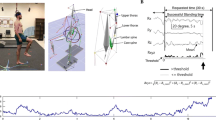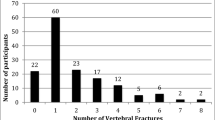Abstract
Summary
Timed loaded standing (TLS) is a suggested measure of back muscle endurance for people with vertebral osteoporosis. Surface electromyography revealed back muscles work harder and fatigue during TLS. The test end-point and total time were associated with back fatigue. The findings help demonstrate the concurrent validity of the TLS test.
Introduction
The TLS test is suggested as a measure of back muscle endurance for patients with vertebral osteoporosis. However, to date, no study has demonstrated that TLS does measure back extensor or erector spinae (ES) muscle endurance. We used surface electromyography (sEMG) to investigate the performance of the thoracic ES muscles during TLS.
Methods
Thirty-six people with vertebral osteoporosis with a mean age of 71.6 (range 45–86) years participated. sEMG recordings were made of the ES at T3 and T12 bilaterally during quiet standing (QS) and TLS. The relative (%) change in sEMG amplitude between conditions was compared. Fatigue was evaluated by analysing the change in median frequency (MF) of the sEMG signal during TLS, and the correlation between maximal TLS time and rate of MF decline was examined.
Results
Activity in the ES increased significantly during TLS at all electrode locations. During TLS, the MF declined at a mean rate of −24.2% per minute (95% C.I. −26.5 to −21.9%). The MF slope and test time were strongly correlated (r2 = 0.71), and at test end, the final MF dropped to an average 89% (95% C.I. 85 to 93%) of initial MF. Twenty-eight participants (78%) reported fatigue was the main reason for stopping, and for eight (22%), it was pain.
Conclusions
This study demonstrates that TLS challenges the ES muscles in the thoracic region and results in ES fatigue. Endurance time and the point at which the TLS test ends are strongly related to ES fatigue.



Similar content being viewed by others
References
Oleksik A, Lips P, Dawson A, Minshall ME, Shen W, Cooper C, Kanis J (2000) Health-related quality of life in postmenopausal women with low BMD with or without prevalent vertebral fractures. J Bone Miner Res 15(7):1384–1392. https://doi.org/10.1359/jbmr.2000.15.7.1384
Briggs AM, Greig AM, Bennell KL, Hodges PW (2007) Paraspinal muscle control in people with osteoporotic vertebral fracture. Eur Spine J 16(8):1137–1144. https://doi.org/10.1007/s00586-006-0276-8
Katzman WB, Vittinghoff E, Kado DM, Schafer AL, Wong SS, Gladin A, Lane NE (2016) Study of hyperkyphosis, exercise and function (SHEAF) protocol of a randomised controlled trial of multimodal spine-strengthening exercise in older adults with hyperkyphosis. Phys Ther 96(3):371–381. https://doi.org/10.2522/ptj.20150171
Kasukawa Y, Miyakoshi N, Hongo M, Ishikawa Y, Noguchi H, Kamo K, Sasaki H, Murata K, Yoichi S (2010) Relationships between falls, spinal curvature, spinal mobility and back extensor strength in elderly people. J Bone Miner Metab 28(1):82–87. https://doi.org/10.1007/s00774-009-0107-1.
Kado DM, Miller-Martinez D, Lui L-Y, Cawthon P, Katzman WB, Hillier TA, Fink HA, Ensrud KE (2014) Hyperkyphosis, kyphosis progression, and risk of non-spine fractures in older community dwelling women: the study of osteoporotic fractures (SOF). J Bone Miner Res 29(10):2210–2216. https://doi.org/10.1002/jbmr.2251
Mika A, Unnithan VB, Mika P (2005) Differences in thoracic kyphosis and in back muscle strength in women with bone loss due to osteoporosis. Spine 30(2):241–246. https://doi.org/10.1097/01.brs.0000150521.10071.df
Granito RN, Aveiro MC, Renno ACM, Oishi J, Driusso P (2012) Comparison of thoracic kyphosis degree, trunk muscle strength and joint position sense among healthy and osteoporotic elderly women: a cross-sectional preliminary study. Arch Gerontol Geriatr 54(2):e199–e202. https://doi.org/10.1016/j.archger.2011.05.012
Hongo M, Miyakoshi N, Shimada YM, Sinaki M (2012) Association of spinal curve deformity and back extensor strength in elderly women with osteoporosis in Japan and the United States. Osteoporos Int 23(3):1029–1034. https://doi.org/10.1007/s00198-011-1624-z
Sinaki M, Khosla S, Limburg PJ, Rogers JW, Murtagh PA (1993) Muscle strength in osteoporotic versus normal women. Osteoporos Int 3(1):8–12. https://doi.org/10.1007/BF01623170
Shipp KM, Purser JL, Gold DT, Pieper CF, Sloane R, Schenkman M, Lyles KW (2000) Timed loaded standing: a measure of combined trunk and arm endurance suitable for people with vertebral osteoporosis. Osteoporos Int 11(11):914–922. https://doi.org/10.1007/s001980070029
Mannion AF, Käser L, Weber E, Rhyner A, Dvorak J, Mȕntener M (2000) Influence of age and duration of symptoms on fibre type distribution and size of the back muscles in chronic low back pain patients. Eur Spine J 9(4):273–281. https://doi.org/10.1007/s005860000189
Mannion AF, Dumas GA, Stevenson JM, Cooper RG (1998) The influence of muscle fibre size and type distribution on electromyographic measures of back muscle fatigability. Spine 23(5):576–584. https://doi.org/10.1097/00007632-199803010-00010
Sions JM, Elliott JM, Pohlig RT, Hicks G (2017) Trunk muscle characteristics of the multifidi, erector spinae, psoas, and quadratus lumborum in older adults with and without chronic low back pain. J Orthop Sports Phys Ther 47(3):173–179. https://doi.org/10.2519/jospt.2017.7002
da Silva RA, Viera ER, Cabrera M, Altimari LR, Aguiar AF, Nowotny AH, Carvalho AF, Oliveira MR (2015) Back muscle fatigue of younger and older adults with and without chronic low back pain using two protocols: a case-control study. J Electromyogr Kines 25(6):928–936. https://doi.org/10.1016/j.jelekin.2015.10.003
Greig AM, Briggs AM, Bennell KL, Hodges PW (2014) Trunk muscle activity is modified in osteoporotic vertebral fracture and thoracic kyphosis with potential consequences for vertebral health. PLoS One 9(10):e109515. https://doi.org/10.1371/journal.pone.0109515
Hodges PW (2001) Changes in motor planning of feedforward postural responses of the trunk muscles in low back pain. Exp Brain Res 141(2):261–266. https://doi.org/10.1007/s002210100873
Hodges PW, Richardson CA (1999) Altered trunk muscle recruitment in people with low back pain with upper limb movement at different speeds. Arch Phys Med Rehab 80(9):1005–1112. https://doi.org/10.1016/S0003-9993(99)90052-7
Gold DT, Shipp KM, Pieper CF, Duncan PW, Martinez S, Lyles KW (2004) Group treatment improves trunk strength and psychological status in older women with vertebral fractures: results of a randomized clinical trial. J Am Ger Soc 52(9):1471–1478. https://doi.org/10.1111/j.1532-5415.2004.52409.x
Wilhelm M, Roskovensky G, Emery K, Manno C, Valek K, Cook C (2012) Effect of resistance exercises on function in older adults with osteoporosis or osteopenia: a systematic review. Physiother Can 64(4):386–394. https://doi.org/10.3138/ptc.2011-31BH
Bennell KL, Mathews B, Greig A, Briggs A, Kelly A, Sherbum M, Larsen J, Wark J (2010) Effects of an exercise and manual therapy program on physical impairments, function and quality-of-life in people with osteoporotic vertebral fracture: a randomised, single-blind controlled pilot trial. BMC Musculoskelet Disord 11:1–11
Valentin G, Maribo T (2014) Hand-held dynamometry fixated with a tripod is reliable for assessment of back extensor strength in women with osteoporosis. Osteoporos Int 25(8):2143–2149. https://doi.org/10.1007/s00198-014-2743-0
Villafaňe JHY, Gobbo M, Peranzoni M, Naik G, Imperio G, Cleland JA, Negrini S (2016) Validity and everyday clinical applicability of lumbar muscle fatigue assessment methods in patients with chronic non-specific low back pain: a systematic review. Disabil Rehabil 38(19):1859–1871. https://doi.org/10.3109/09638288.2015.1107777
Sung PS, Lammers AR, Danial P (2009) Different parts of erector spinae muscle fatigability in subjects with and without low back pain. Spine J 9(2):115–120. https://doi.org/10.1016/j.spinee.2007.11.011
Criswell E (ed) (2011) Cram’s introduction to surface electromyography, 2nd edn. Jones and Bartlett Publishers, Sudbury, Massachusetts
Moffroid M, Reid S, Henry SM, Haugh LD, Ricamato A (1994) Some endurance measures in persons with chronic low back pain. J Orthop Sports Phys Ther 20(2):81–87. https://doi.org/10.2519/jospt.1994.20.2.81
Tsuboi H, Nishimura Y, Sakata T, Ohko H, Tanina H, Kouda K, Nakamusa T, Umezu Y, Tajima F (2013) Age related differences in erector spinae muscle endurance using surface electromyographic power spectral analysis in healthy humans. Spine J 13(12):1928–1933. https://doi.org/10.1016/j.spinee.2013.06.060
Mohseni-Bandpei MA, Rahmani N, Majdoleslam B, Abdollahi I, Shah S, Ahmad A (2014) Reliability of surface electromyography in the assessment of paraspinal muscle fatigue. J Manip Physiol Ther 37(7):510–521. https://doi.org/10.1016/j.jmpt.2014.05.006
Greendale GA, Nili NS, Huang MH, Seeger L, Karlamangla AS (2011) The reliability and validity of three non-radiological measures of thoracic kyphosis and their relations to the standing radiological Cobb angle. Osteoporos Int 22(6):1897–1905. https://doi.org/10.1007/s00198-010-1422-z
https://www.iofbonehealth.org/quality-life-questionnaires-qualeffo-41. Accessed May 2017
Lee LJ, Coppieters MW, Hodges PW (2009) Anticipatory postural adjustments to arm movement reveal complex control of paraspinal muscles in the thorax. J Electromyogr Kines 19(1):46–54. https://doi.org/10.1016/j.jelekin.2007.06.015
Larivière C, Arsenault AB, Gravel D, Gagnon D, Loisel P (2002) Evaluation of measurement strategies to increase the reliability of EMG indices to assess back muscle fatigue and recovery. J Electromyogr Kines 12(2):91–102. https://doi.org/10.1016/S1050-6411(02)00011-1
de Seze MP, Cazalets J-R (2008) Anatomical optimization of skin electrode placement to record electromyographic activity of erector spinae muscles. Surg Radiol Anat 30(2):137–143. https://doi.org/10.1007/s00276-007-0289-y
Halaki M, Ginn K (2012) Normalisation of EMG signals: to normalise or not to normalise and what to normalise to? Computational intelligence in electromyographic analyses -a perspective on current applications and future challenges. In: Naik GR (ed) InTech. https://doi.org/10.5772/49957. https://www.intechopen.com/books/computational-intelligence-in-electromyography-analysis-a-perspective-on-current-applications-and-future-challenges/normalization-of-emg-signals-to-normalize-or-not-to-normalize-and-what-to-normalize-to-. Accessed October 2017
Mannion AF, Dolan P (1994) Electromyographic median frequency changes during isometric contraction of the back extensors to fatigue. Spine 19(11):1223–1229. https://doi.org/10.1097/00007632-199405310-00006
Kankaanpää M, Taimela S, Laaksonen D, Hänninen O, Airaksinen O (1998) Back and hip extensor fatigability in chronic low back pain patients and controls. Arch Phys Med Rehab 79:412–417
Dolan P, Mannion AF, Adams MA (1995) Fatigue of the erector spinae muscles: a quantitative assessment using “frequency banding” of the surface electromyographic signal. Spine 20(2):149–159. https://doi.org/10.1097/00007632-199501150-00005
Carpenter J, Bithell J (2000) Bootstrap confidence intervals: when, which, what? A practical guide for medical statisticians. Statist Med 19(9):1141–1164. https://doi.org/10.1002/(SICI)1097-0258(20000515)19:9<1141::AID-SIM479>3.0.CO;2-F
Fox J (2002) Bootstrapping regression models. In: Fox J (ed) An R and S-Plus companion to applied regression. Sage, Thousand Oaks, Appendix pp 1–14
Aruin AS, Latash ML (1995) Directional specificity of postural muscles in feed-forward postural reactions during fast voluntary arm movements. Exp Brain Res 103(2):323–332
Takahashi K, Yamaji T, Wada N, Shirakura K, Watanabe H (2015) Trunk kinematics and muscle activities during arm elevation. J Orthop Sci 20(4):624–632. https://doi.org/10.1007/s00776-015-0724-6
Takahashi I, Shin-ichi K, Sato K, Iwabuchi M (2007) Effects of the mechanical load of forward bending motion of the trunk. Comparison between patients with motion-induced intermittent back pain and healthy subjects. Spine 32(2):E73–E78. https://doi.org/10.1097/01.brs.0000252203.16357.9a
Enomoto M, Ukegawa D, Sakaki K, Tomizawa S, Arai Y, Kawabata S, Kato T, Yoshii T, Shinomiya K, Okawa A (2012) Increase in paravertebral muscle activity in lumbar kyphosis patients by surface electromyography compared with lumbar spinal canal stenosis patients and healthy volunteers. J Spinal Disord Tech 25(6):E167–E173. https://doi.org/10.1097/BSD.0b013e31825d63c4
Eyskens JB, Nijs J, D’Août K, Sand A, Wouters K, Moorkens G (2015) Timed loaded standing in female chronic fatigue syndrome compared with other populations. J Rehabil Res Dev 52(1):21–30. https://doi.org/10.1682/JRRD.2014.03.0086
Cardozo AC, Gonçalves M (2010) Effect of load level on the EMG spectra of longissimus thoracis muscle during isometric fatiguing contractions. Electromyogr Clin Neurophysiol 50(2):75–85. http://www.researchgate.net/publication/43225743
Konrad P (2006) The ABC of EMG: a practical introduction to kinesiological electromyography, 1.4 edn. Noraxon, USA. https://www.noraxon.com/wp-content/uploads/2014/12/ABC-EMG-ISBN.pdf
Acknowledgements
This study was funded by the National Institute for Health Research Health Technology Assessment programme under its commissioned research programme (HTA 10/99/01). It is also supported by the NIHR Biomedical Research Unit at Nuffield Department of Orthopaedics, Rheumatology and Musculoskeletal Sciences, University of Oxford.
Author information
Authors and Affiliations
Corresponding author
Ethics declarations
Conflicts of interest
None.
Appendix
Appendix
Rights and permissions
About this article
Cite this article
Newman, M., Newman, R., Hughes, T. et al. Is the timed loaded standing test a valid measure of back muscle endurance in people with vertebral osteoporosis?. Osteoporos Int 29, 893–905 (2018). https://doi.org/10.1007/s00198-017-4358-8
Received:
Accepted:
Published:
Issue Date:
DOI: https://doi.org/10.1007/s00198-017-4358-8




